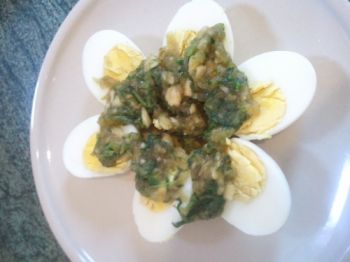Broadcast: News items
Easter eggs Tudor style: Student serves up 400-year-old recipe
Posted on behalf of: Press and communications
Last updated: Wednesday, 4 April 2012

Eggs with green sauce
University of Sussex historian and foodie Maria Kirk has served up a 400-year-old Easter egg recipe – but chocolate lovers might be disappointed.
Maria is currently researching collections of Early Modern plays kept at Sussex stately home Petworth House for a collaborative project involving the University of Sussex and the National Trust.
The main focus of her research is the relationship between dramatic performance and consumption at Petworth and in the wider 17th-century English country house scene, concentrating on depictions of feasting, luxury and plenty.
But in her spare time Maria, a self-confessed “food nerd”, also researches 16th and 17th-century recipes and then tries them out in her kitchen. The resulting dishes – good and bad – can be viewed on her blog, Gastronomy Archaeology.
In her search for Easter treats, Maria came across references to “sodden eggs with greene sauce” – boiled eggs served with a green dressing made from herbs. The dish features in a book by the Delia Smith of his day, Thomas Dawson –The Second Part of the Good Huswives Jewell (1597) – in which he offers some advice on the foods to be eaten at Easter.
Maria says: “Eggs are associated with Easter today, and it seems that they were in the Early Modern period too. Eggs were a forbidden food during Lent. Once Easter arrived, they were back on the menu.”
Maria’s Easter recipe, taken from Hannah Woolley’s The Accomplish’d Lady’s Delight (1675) consists of boiled eggs dressed with a sauce made with apples, vinegar, sorrel and sugar.
The result, says Maria, was rather pleasant: “I quite enjoyed this dish, the green sauce is sharp and sweet and quite tasty. My mum tried them too and said they were rather nice. It would make an interesting addition to an Easter buffet. It’s also very easy to make if you don’t mind a bit of work with the pestle and mortar. It is worth seeking out sorrel for this – it’s an underrated herb in my opinion.”

